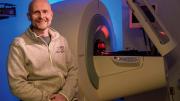Sleep, diet, exercise, and stress: these are factors known to change a person’s risk of developing numerous non-communicable diseases. Such lifestyle impacts on health—beneficial or harmful—exert much of their influence via inflammation. About 10 years ago, Matthias Nahrendorf began wondering just how inflammation and lifestyle might be linked biologically, and started thinking about how to pinpoint the mechanism in the cardinal case of cardiovascular disease.
A person’s level of inflammation can easily be measured with a simple white blood cell test. White blood cells fight off bacterial invasions and repair damaged tissues, but they can also damage healthy tissue when they become too abundant. “You can find them in atherosclerotic plaques, and you can find them in acute infarcts,” says Nahrendorf, a professor of radiology who conducts high-resolution imaging research at Massachusetts General Hospital. “You can find them in failing hearts and the brain,” where they increase the risk of stroke.
By linking exercise to reduced white blood cell production, Nahrendorf shows how a lifestyle factor can modulate cardiovascular risk.
When Nahrendorf learned that the most potent, toxic, and pro-inflammatory white blood cells live only a few hours, or at most a day, he immediately realized that the paramount questions—given that they die off quickly yet remain abundant in the blood—are, where and why are they produced? What is their source? Perhaps, he hypothesized, lifestyle factors regulate hematopoiesis (blood production).
To test this idea, he decided to study the effects of exercise on the production of these leukocytes in healthy mice. First, though, he consulted the scientific literature on exercise in mice. Previous researchers, he learned, had found that exercise increases production of inflammatory immune cells—“which I thought was counterintuitive,” Nahrendorf recalls. When he looked more carefully, he discovered that the type of exercise used in the studies was “forced” and thus “possibly stressful” because it was induced by electric shocks. He therefore decided to test only voluntary exercise. He and his colleagues put a wheel in each mouse’s cage, so the animals could “choose to run if they were interested.”
The mice never ran during the day. “That is when they rest,” Nahrendorf explains. But in the dark, they ran a lot, averaging “six to seven miles every night.” After three weeks, the exercising mice had measurably lower levels of circulating white blood cells. Exercise, he found, had pushed their blood stem cells (cells that can produce all the different types of blood cells) into a state of quiescence: a kind of dormancy in which they generate fewer pro-inflammatory white blood cells and platelets, without decreasing the number of oxygen-carrying red blood cells. Soon the exercising mice had fewer circulating white blood cells than their sedentary counterparts, dampening inflammation—an effect that persisted for weeks.
The local signals within bone marrow that induce quiescence in blood stem cells were already well known, but the fact that exercise could trigger them was not. Nahrendorf next wanted to learn the identity of the trigger linking exercise to blood stem cell quiescence. Further investigation revealed that the only receptors with enhanced activity in the bone marrow niche where most blood stem cells exist were binding to a well-known hormone called leptin; it is produced by fat cells and regulates hunger.
Leptin is like the fuel gauge in a car. When the tank is full—meaning energy (and food) are abundant—leptin levels run high. As exercise uses up the gas in the tank, this lowers leptin levels, which signal that reserves are running low, thereby inducing hunger and the urge to eat in order to replenish depleted energy stores. Nahrendorf and his co-authors speculate in their 2019 Nature Medicine paper that leptin’s “role in regulating energetically costly hematopoiesis may have evolved to produce blood cells” only when whole body energy was abundant—not when people are exerting themselves. “Contemporary sedentary behavior,” they continue, “which increases leptin and consequently hematopoiesis, may have rendered this adaptation a risk factor for cardiovascular disease (CVD) and perhaps also for other diseases with inflammatory components.”
But with fewer circulating immune cells, would exercising mice be more vulnerable to infection? Nahrendorf challenged them with a protocol designed to induce infection in the blood, and found just the opposite: exercising mice had a more robust immune response, as semi-dormant blood stem cells swiftly sprang into activity and produced infection-fighting leukocytes, improving survival of the active mice as compared to those with no running wheels in their cages. Next, they investigated whether exercise would help mice with established atherosclerosis, and found that exercise was not only protective, it also reduced the size of existing plaques in the aorta.
Whether these associations would hold up in humans remained an open question. For answers, Nahrendorf turned to a study known as CANTOS, which had measured levels of inflammation in 4,892 patients who suffered heart attacks (see “Raw and Red Hot,” May-June 2019, page 46). When he approached the study’s co-authors, Mallinckrodt professor of medicine Peter Libby and Braunwald professor of medicine Paul Ridker, he learned, serendipitously, not only that they possessed self-reported exercise levels for the participants, but also that they had tested leptin levels as well. They analyzed their raw data and found “the same relationship among exercise, leptin, and leukocytes as in the mice.” Data from a second human study cemented the result.
By identifying a previously unknown molecular mechanism linking voluntary exercise to reduced white blood cell production, Nahrendorf and his colleagues have highlighted how a lifestyle factor can modulate cardiovascular risk. Their discovery, the researchers hope, will point the way to wider adoption of healthy exercise regimens, and health-enhancing anti-inflammatory drugs.









